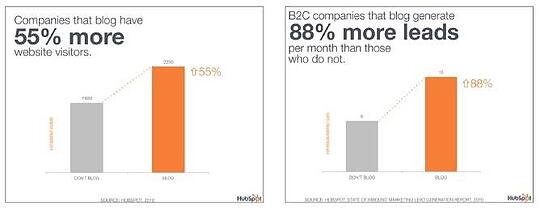4 Website Content Must Haves to Drive Traffic, Boost Leads & Soar Sales

 There are several key elements to creating a successful website such as conversion optimization, SEO design, and usability, but today I want to focus on another major component that continues to be imperative: content.
There are several key elements to creating a successful website such as conversion optimization, SEO design, and usability, but today I want to focus on another major component that continues to be imperative: content.
With Inbound Marketing on the rise, and content marketing being a key part of its strategy, content is escalating in popularity among marketers. I like to think of it as the oil in your Inbound Marketing engine that drives search engines and targeted prospects to your website.
The content that visitors discover on your website can make or break your business – it is literally the difference between someone bailing on your website or someone sticking around on your website to gather and process more information that hopefully converts them from a prospect into a lead.
Check out these next must-haves for creating killer website content.
1. Create Clear Messaging that Educates & Offers Value
Within seconds of landing on your website, an internal dialogue begins in the mind of your prospect:
- Where am I?
- What can I do on this website?
- Why should I do it?
Ideally, you want your content to answer these questions for them so they’re not left guessing. You can do this by writing an attention-grabbing headline and supporting text on your home page that uses a powerful value proposition so visitors know right away why they should buy from you. Write clearly and don’t use generic marketing clichés.
Today’s marketing audience is much savvier and they are leery of any marketing message full of hype. Just get straight to the point and be clear about what your products or services can do for them.
But some people still won’t be ready to buy from you right away. You’ve always got your fast decision makers ready to make an immediate decision and slower decision makers who need a bit more nurturing. With all of the good product and service information presented on your website, people won’t always be ready to “add to cart” or pick up the phone to call you,so you need to get them to stick around. Here are a couple of ways to do that.
2. Avoid Content That is Only Self-Serving
You should offer content that is beneficial to your customers, be it educational, a list of sales tips, or takeaways they can actually use and implement in their own business.
You can do this in the form of eBooks, whitepapers, case studies, marketing plans and more. When content is educational, it nurtures prospects through the sales and marketing funnel until they are ready to buy from you.
And since content offers are educational, it makes prospects feel like they are getting valuable information for free and not just a constant sales pitch to buy from you.
When writing these content offers, make sure to speak directly to your target audience by using words such as “you” and “we.” Keep content transparent and never lose your human tone of voice. Address their problems while speaking to their needs and it’s likely they won’t forget you.
Content about your products should be written as a problem solver and not just selling points. Don’t toot your own horn with statements such as “we are the best” - instead define how your products and services will specifically help your customer’s solve their pain points.
3. Create High-Quality Content
A lot of content is good but quality trumps quantity every time. And it’s not just your customers who know it. The search engine algorithms are getting smarter too and they can detect the good from the bad. Here’s a checklist to make sure the content on your site passes human (and search engine robot) inspection:
- Write and offer your target market unique content
- Write content that speaks to humans, not search engines
- Provide valuable and educational content that helps your target audience solve their problems
- Keep content fresh on your website by rewriting it every year, especially the primary content on the home page. *Bonus Tip: Start a company blog and publish to it at least twice a week. This is an easy and effective way to always post something new to your websites. Your customers and the search engines will definitely take notice
- Know your target audience and provide content that is specific and relevant to their pain points
4. Start a Blog
A blog is a key component to your Inbound Marketing strategy. Here are some of the ways blogging helps your business:
- Routinely create pages of fresh content – prospective customers (and search engines!) love that
- Establish yourself as an authority and thought leader in your industry by publishing informative articles
- Get an SEO boost from all of the fresh content and building of valuable inbound links, which means more traffic and leads coming into your site
- Talk to and engage your target audience and prospective customers on a platform you control
It may sound like a lot to do but blogging does not have to be hard. Once you have your publishing plan and the right tools in place, you’re off and running.
But if you don’t have the tools or the time to create and publish content on a consistent basis, an experienced and certified Inbound Marketing agency can help you get started.
If you’re still not convinced blogging works, HubSpot has done a lot of research on it. Check out this particularly astounding stat:
As you can see, companies that blog more get more website visitors and leads than those who don’t.
5. Make Your Content Easy to Share to Generate Social Buzz
Social media has grown tremendously over the last 10 years and continues to grow in popularity every day. Whether you’re on your personal Facebook page or browsing a company’s LinkedIn profile, at some point you’ve seen someone “Like” a post, share a picture, or link to a blog article.
And you probably paused to check out these posts too; maybe you even shared it with your friends.
Well imagine people paying your business’ social media shares and posts this kind of attention. It can happen, you just have to make it easy for people to share and socialize around your content.
One way to do this is by adding social sharing widgets and plug-ins to each page of your website, and on your blog articles. All of the top social media platforms (Facebook, Twitter, Google+, LinkedIn) have code you can embed on your web pages and blog articles that will place a button promoting people to “like”, “retweet”, “plus one” or “share. Now you’re making it convenient and super easy for people to spread your content on the Internet.
Adding a plug-in to your blog not only allows people to share a direct link to your articles but it can even be set up to auto-publish your most recent blog posts to social networks so you don’t have to remember to manually do it. As soon as your blog post publishes, your audience will get it delivered to them socially as well.
Bottom Line – It’s Not Enough To Just Be Pretty
In today’s marketplace, it’s not enough to just have a pretty website. You’ve got to have an Inbound Marketing strategy in place that takes content marketing and integrates it with those other key components we talked about earlier, such as conversion optimization, SEO, design and usability.
When successfully integrated, these components combine to create a powerful Inbound Marketing strategy that generates website traffic, leads and sales for your business.
If you’d like to hear more, we’d love to talk to you and review your personal business needs using our Inbound Marketing assessment.
To learn more, click here.








